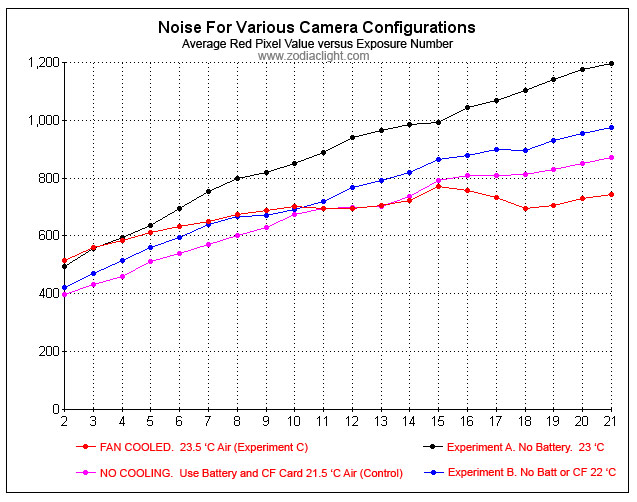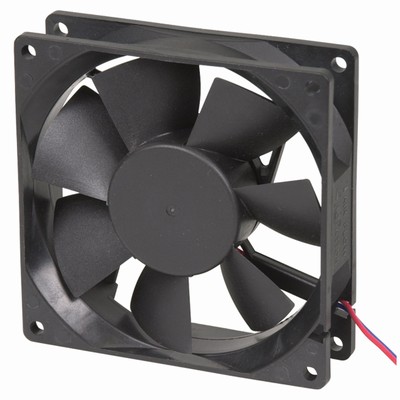CAMERA NOISE EXPERIMENT (Part 4)
Back to Part 1 Part 2 Part 3
Part 5
FAN COOLING
This is the fourth part of a series of experiments. The experiments
concern noise and noise sources in a Canon 350D DSLR. In Part 4 we will do 3
experiments on a Canon 350D camera. The 3 experiments (A, B and C) are performed on
3 different configurations of the Canon 350D.:
Experiment A: Battery removed. (Use external power source);
Compact Flash (CF) card is installed and in use;
Experiment B: Battery removed. CF card removed. (Download pictures via
USB 2.0 immediately to computer);
Experiment C: Battery removed. CF card removed. 12V fan placed 3cm from the
LCD screen at back of camera.
The noise (the average red pixel value) is measured for each exposure in a
series of exposures taken in quick succession (spaced 10 seconds apart). Each
experiment changes only one aspect of the camera's configuration so we can observe which,
if any, change results in less noise.
Interpreting the Results. Success.
a) When a FAN is used noise increases to only 1.25 times the value it was
when the camera was first turned on;
b) Without the FAN noise increases to about 2.1 times the value it was when the camera was
first turned on;
c) Comparing Experiment A with Experiment C the difference between an uncooled and a
FAN-cooled camera becomes noticable at the 7th exposure;
d) Examining Experiment A an uncooled camera at 23.5 C noise will start at ~500 and
increase past ~1200 units;
e) Examining Experiment B a fan-cooled camera at 23.0 C noise will start at ~500 and
stablises at ~700 units;
f) The Control experiment started at much lower temp (21.5C) but still finished noiser
than a fan-cooled camera;
g) For a very long sequence (25+) of 2 minute exposures the FAN is obviously
effective in reducing noise;
h) The fan-cooled camera seems to stabilise (trend) so that noise is not increasing after
the 12th exposure;
i) The camera is like a thermometer. Small changes in air temperature have a large
(linear?) effect;
j) The fan does not create dew or moisture on the camera (it's likely to have the opposite
effect);
k) Fan cooling a Canon 350D will be highly effective not considering the effect of
vibration; and
l) The effect of fan vibration on the image quality of astrophotos cannot be
determined from this experiment.
In the graph the red and the black lines are perhaps the most interesting
showing clearly the two different camera configurations starting at approximately the same
temperature and therefore start noise value. The uncooled camera shows continuing
linear noise increase however the cooled camera reaches equilibrium after the 10th
exposure.

Graph is a 3-point moving average of the data in the tables
Control is the experimental data from old Part 3.
EQUIPMENT & METHOD
Canon EOS 350D (unmodified) In-camera Noise Reduction Off;
ISO 1600; 120 sec exposures; 10 seconds pause between exposures;
Compact Flash (CF) Card is removed;
The fan is 12 volt Sirocco Model YX2521
A digital thermometer was used to measure air temperature (50cm distant) for each
exposure.
RAW DATA
|
Experiment A
No Battery |
Experiment B
No Batt. & No CF Card |
Experiment C
Fan Cooling |
|
| Sub |
Temp
Deg C |
Ave. Red
Pixel Value |
Temp
Deg C |
Ave. Red
Pixel Value |
Temp
Deg C |
Ave. Red
Pixel Value |
Reference
Elapse Time |
| 1 |
23.0 |
406 |
21.9 |
403 |
23.5 |
449 |
00:00 |
| 2 |
23.1 |
492 |
21.9 |
411 |
23.5 |
539 |
02:10 |
| 3 |
23.1 |
583 |
21.9 |
456 |
23.5 |
554 |
04:20 |
| 4 |
23.0 |
598 |
21.6 |
547 |
23.4 |
589 |
06:30 |
| 5 |
23.1 |
603 |
21.6 |
542 |
23.4 |
607 |
08:40 |
| 6 |
23.1 |
704 |
21.9 |
593 |
23.5 |
639 |
10:50 |
| 7 |
23.0 |
783 |
21.9 |
647 |
23.5 |
651 |
13:00 |
| 8 |
22.7 |
776 |
21.9 |
681 |
23.5 |
660 |
15:10 |
| 9 |
22.7 |
837 |
21.9 |
679 |
23.5 |
716 |
17:20 |
| 10 |
22.8 |
843 |
21.9 |
656 |
23.5 |
687 |
19:30 |
| 11 |
23.0 |
873 |
21.9 |
737 |
23.5 |
702 |
21:40 |
| 12 |
22.9 |
949 |
21.9 |
769 |
23.5 |
694 |
23:50 |
| 13 |
22.7 |
1002 |
21.9 |
801 |
23.5 |
689 |
26:00 |
| 14 |
22.7 |
939 |
22.0 |
809 |
23.5 |
734 |
28:10 |
| 15 |
22.9 |
1020 |
21.9 |
850 |
23.6 |
749 |
30:20 |
| 16 |
23.1 |
1022 |
21.9 |
934 |
23.6 |
827 |
32:30 |
| 17 |
23.3 |
1086 |
21.7 |
851 |
23.5 |
696 |
34:40 |
| 18 |
23.4 |
1098 |
21.9 |
913 |
23.5 |
677 |
36:50 |
| 19 |
23.5 |
1127 |
21.9 |
919 |
23.3 |
717 |
39:00 |
| 20 |
23.4 |
1198 |
22.1 |
960 |
23.1 |
718 |
41:10 |
| 21 |
|
|
22.2 |
981 |
23.1 |
753 |
43:20 |
| 22 |
|
|
21.9 |
981 |
23.2 |
757 |
45:30 |
| 23 |
|
|
21.7 |
989 |
23.4 |
739 |
47:40 |
| 24 |
|
|
21.7 |
1003 |
23.5 |
691 |
49:50 |
| 25 |
|
|
21.6 |
1079 |
23.7 |
714 |
52:00 |
| 26 |
|
|
21.7 |
1104 |
23.5 |
745 |
54:10 |
** These are dark frames so the average value of Red pixels is used here
in the table as a measure of noise. Noise is as measured in MaxDSLR using Info
dialog set to Area.
 |
BRUSHLESS 90mm FAN SIROCCO MODEL YX2521
* Air volume 59CFM
* Input power 3.8watts
* Impeller Plastic, fibreglass
filled
* Housing Plastic, fibreglass filled
* Speed 3,000rpm
* Noise 36dBA
* Size
90 x 90 x 25mm
* Bearing Sleeve
* Current 0.32A |
Read the introduction for these experiments here.
Go to Part 1 Part 2 Part3 Part 5
Back to Astrophotography
|

